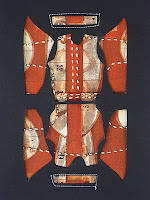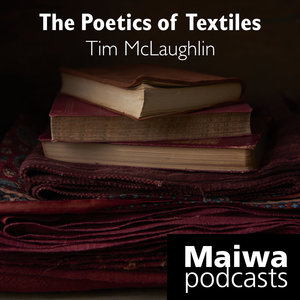Our latest podcast just went up.
 Part 1 - Presentation
Part 1 - Presentation
Gasali Adeyemo
In this lecture master craftsman Gasali Adeyemo opens the evening with a description of his early life in Nigeria and tells how fibre art came into his life. As a participant of the Nike Centre for Arts and Culture, both as a student and later as a teacher, Gasali encountered a range of traditional crafts. He gives a description of the famous adire techniques and illustrates how they relate to Yoruba culture.
Recorded at the 2007 Maiwa Textile Symposium on October 25, 2007
Posted May 2009
The adire eleko (starch-resist) cloths of the Yoruba are immediately identifiable by their hand-drawn patterning and unique symbolism with its wealth of proverbial meaning. The lines, traditionally drawn with a quill, give these cloths the characteristics of a large illustrated canvas.
The adire oniko (tied resist) is often used as a woman’s wrap. Small wraps are first folded then tie-dyed to create spiral designs. One special variation, known as the etu (guinea-fowl pattern) is so prized that when untied it is neither washed nor ironed.
Gasali Adeyemo
Gasali Adeyemo grew up in Ofatedo, Nigeria, where he put himself through high school by sketching portraits at social gatherings. He studied for six years at the Nike Centre for Arts and Culture and then remained an additional four as a teacher.
In 1995 Gasali exhibited his textiles in Bayruth, Germany, and his international reputation was born. A participant in the Iowa Color Congress 2002, the World Batik Conference, and Fiber Arts Center, Gasali has made it his life’s work to give workshops, presentations, and lectures in order to communicate the beauty of adire textiles and share the Yoruba culture
Gasali Adeyemo
In this lecture master craftsman Gasali Adeyemo opens the evening with a description of his early life in Nigeria and tells how fibre art came into his life. As a participant of the Nike Centre for Arts and Culture, both as a student and later as a teacher, Gasali encountered a range of traditional crafts. He gives a description of the famous adire techniques and illustrates how they relate to Yoruba culture.
Recorded at the 2007 Maiwa Textile Symposium on October 25, 2007
Posted May 2009
The adire eleko (starch-resist) cloths of the Yoruba are immediately identifiable by their hand-drawn patterning and unique symbolism with its wealth of proverbial meaning. The lines, traditionally drawn with a quill, give these cloths the characteristics of a large illustrated canvas.
The adire oniko (tied resist) is often used as a woman’s wrap. Small wraps are first folded then tie-dyed to create spiral designs. One special variation, known as the etu (guinea-fowl pattern) is so prized that when untied it is neither washed nor ironed.
Gasali Adeyemo
Gasali Adeyemo grew up in Ofatedo, Nigeria, where he put himself through high school by sketching portraits at social gatherings. He studied for six years at the Nike Centre for Arts and Culture and then remained an additional four as a teacher.
In 1995 Gasali exhibited his textiles in Bayruth, Germany, and his international reputation was born. A participant in the Iowa Color Congress 2002, the World Batik Conference, and Fiber Arts Center, Gasali has made it his life’s work to give workshops, presentations, and lectures in order to communicate the beauty of adire textiles and share the Yoruba culture





































